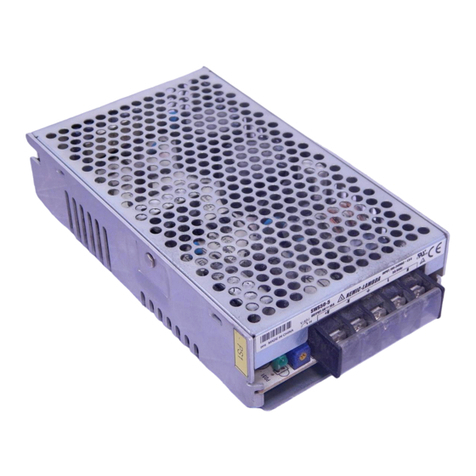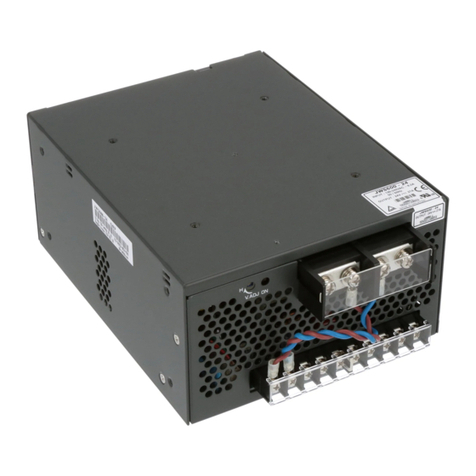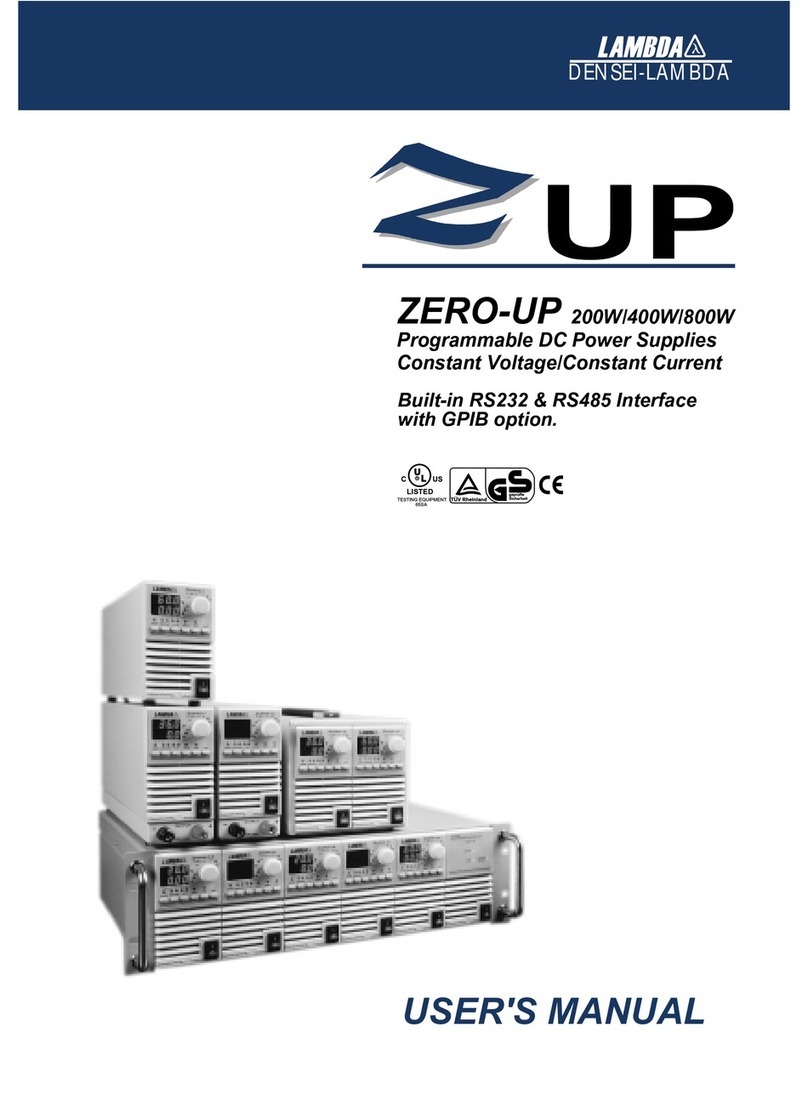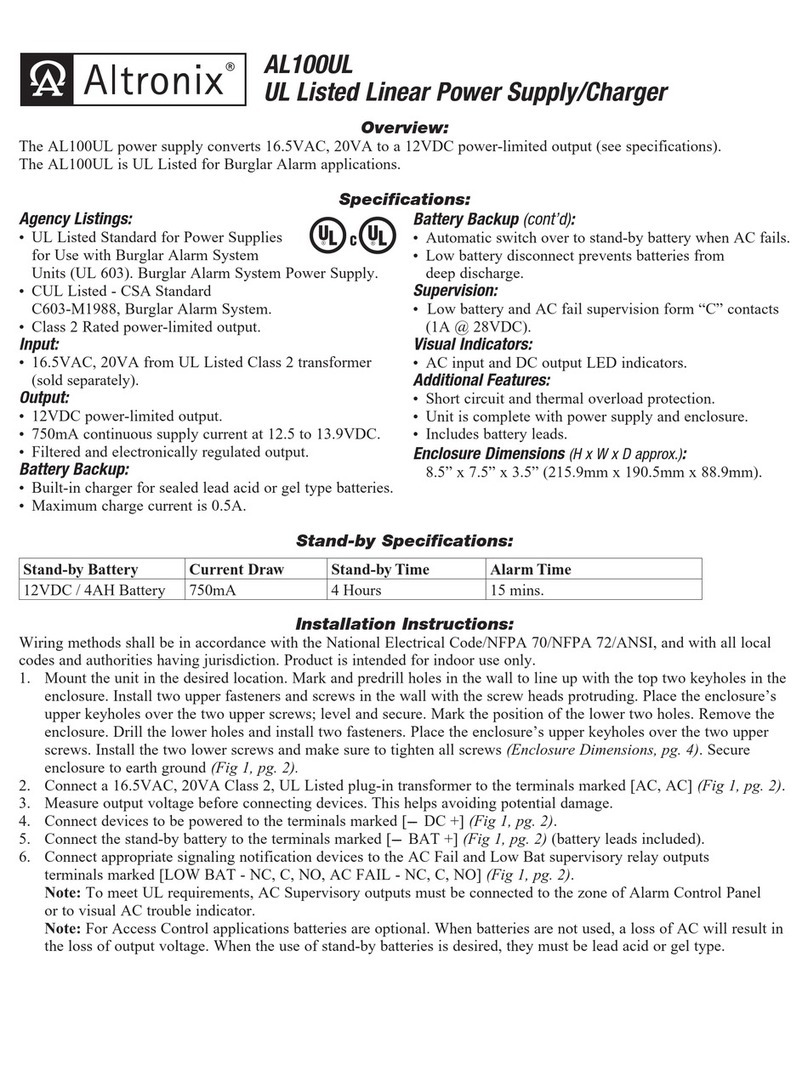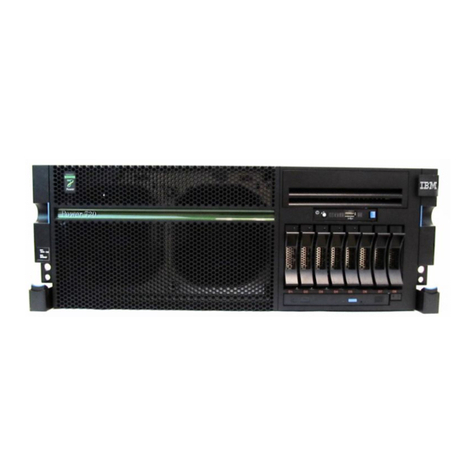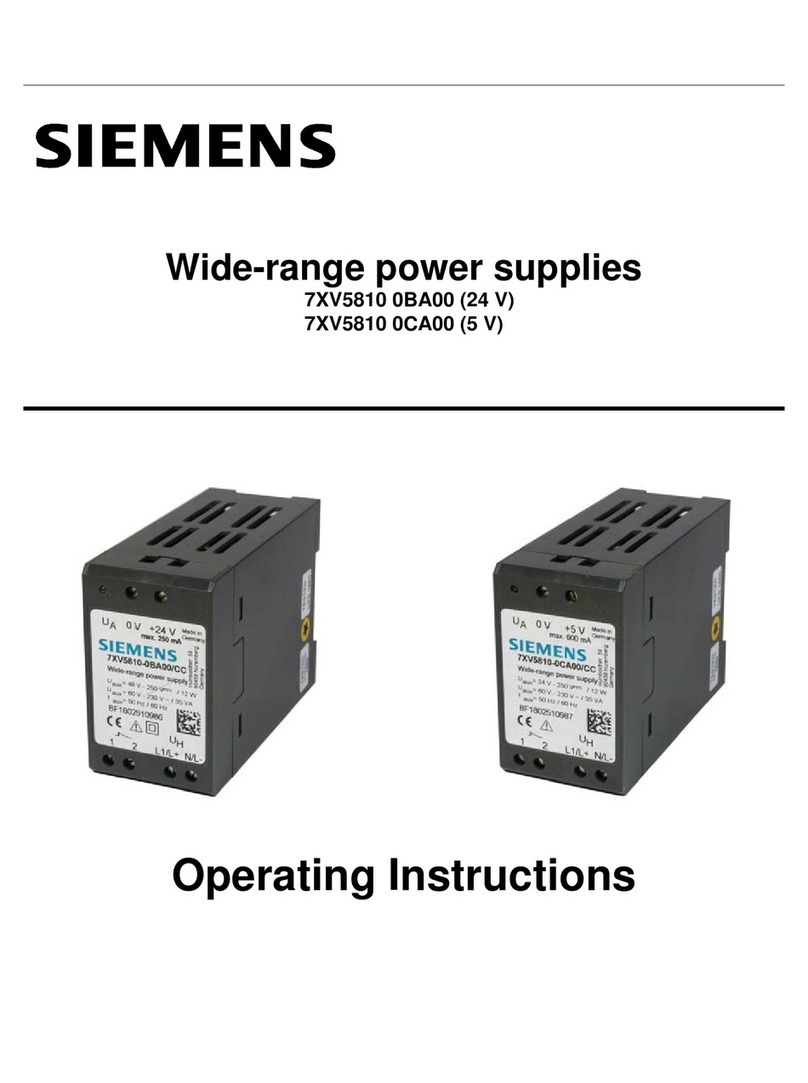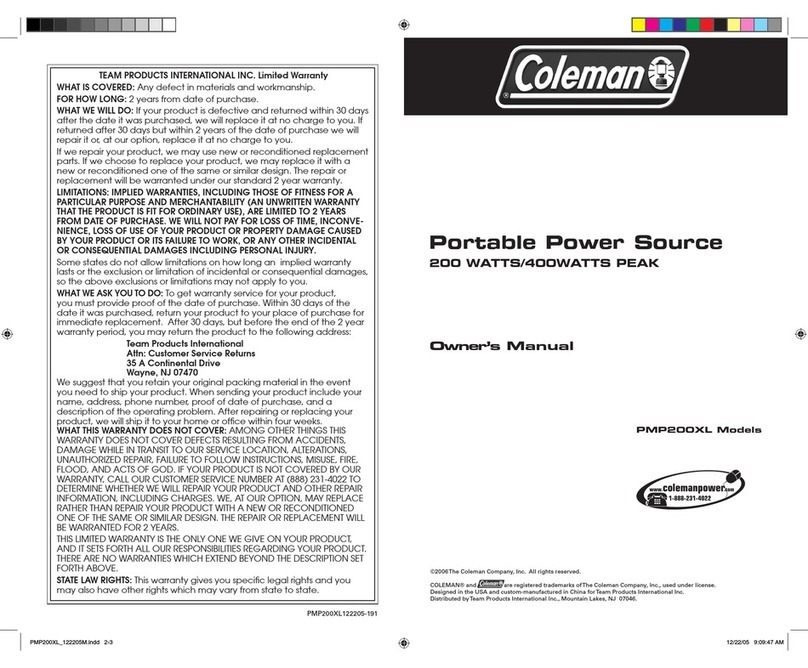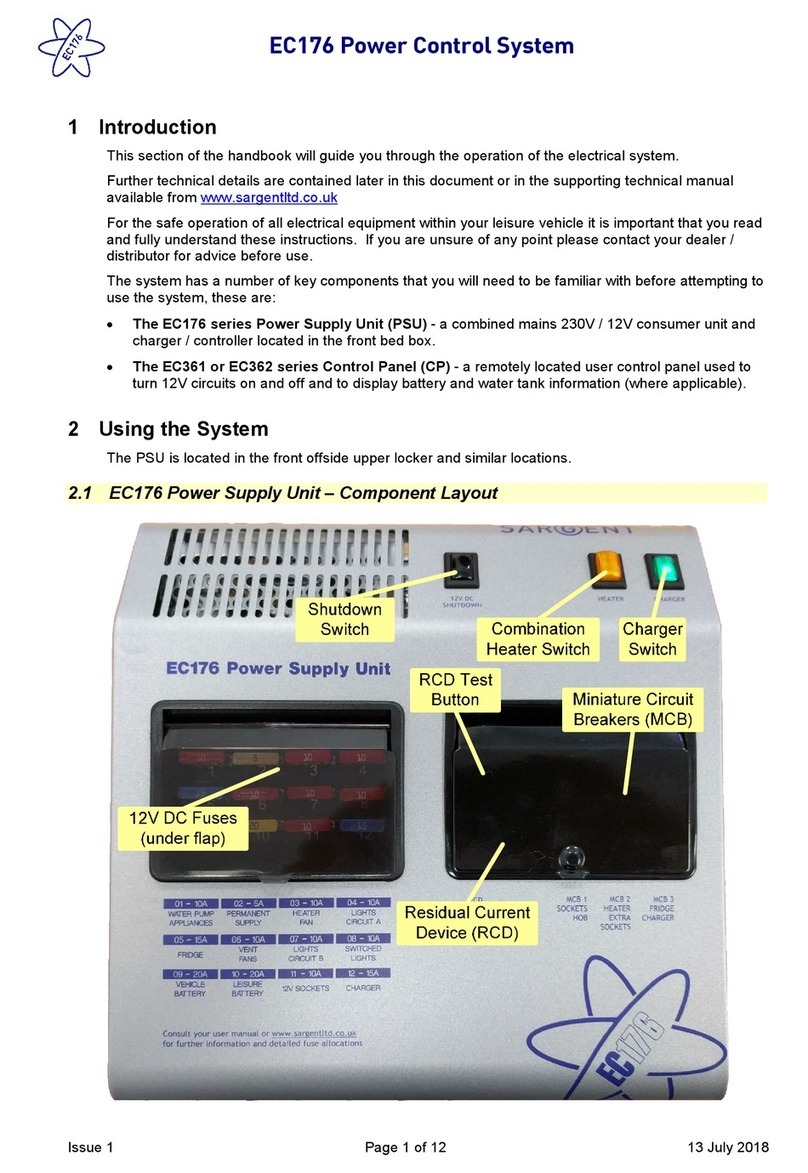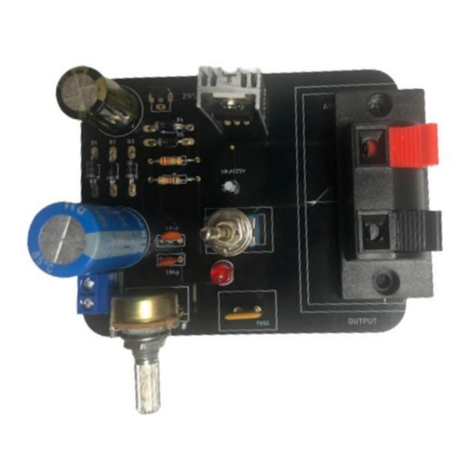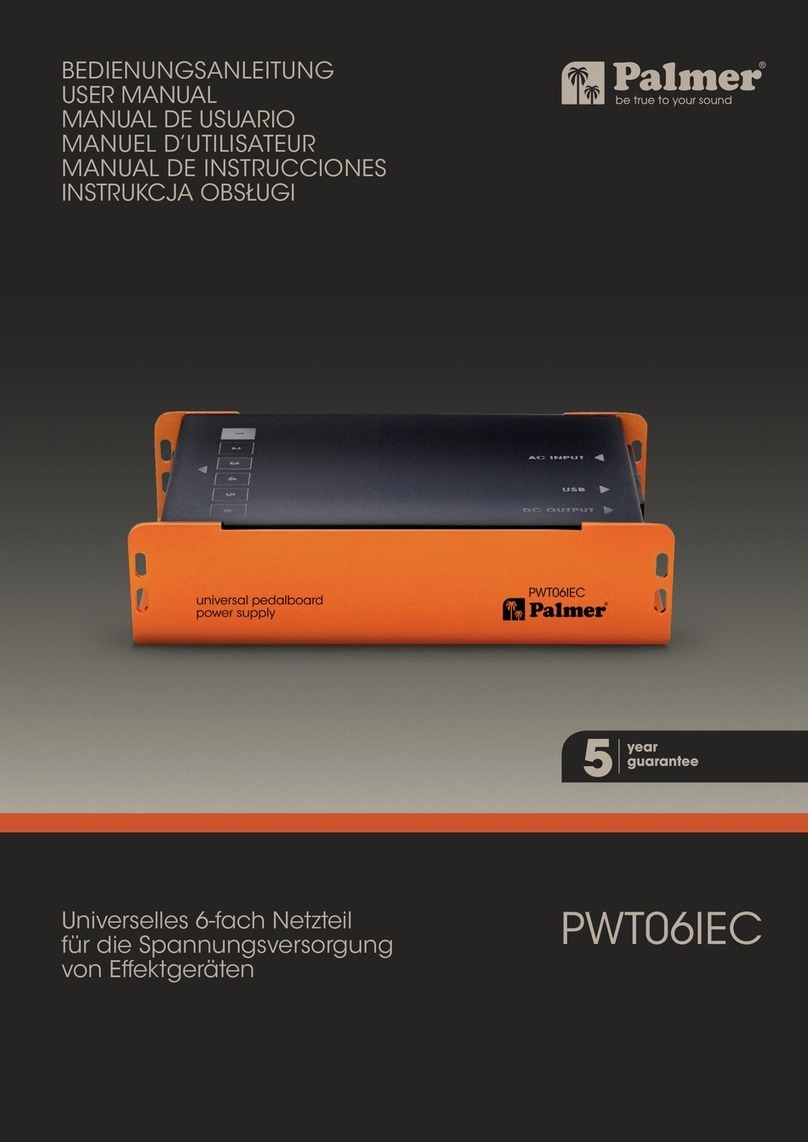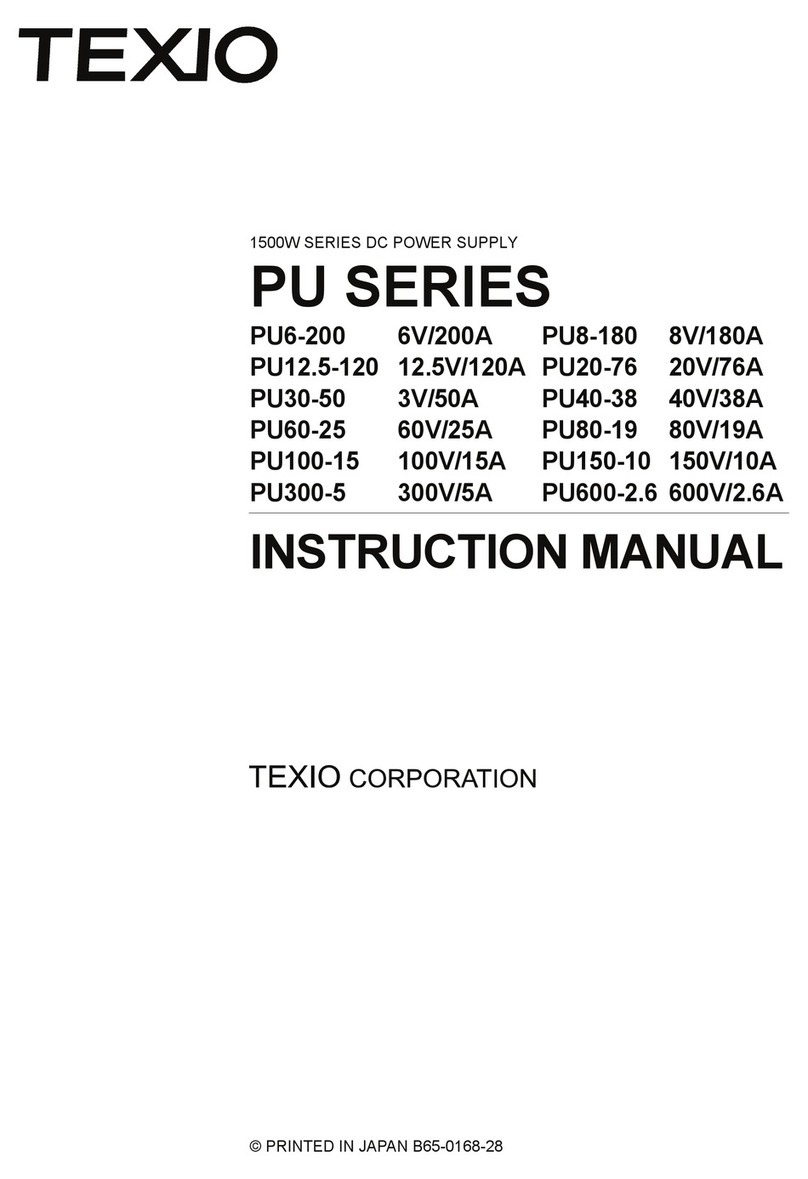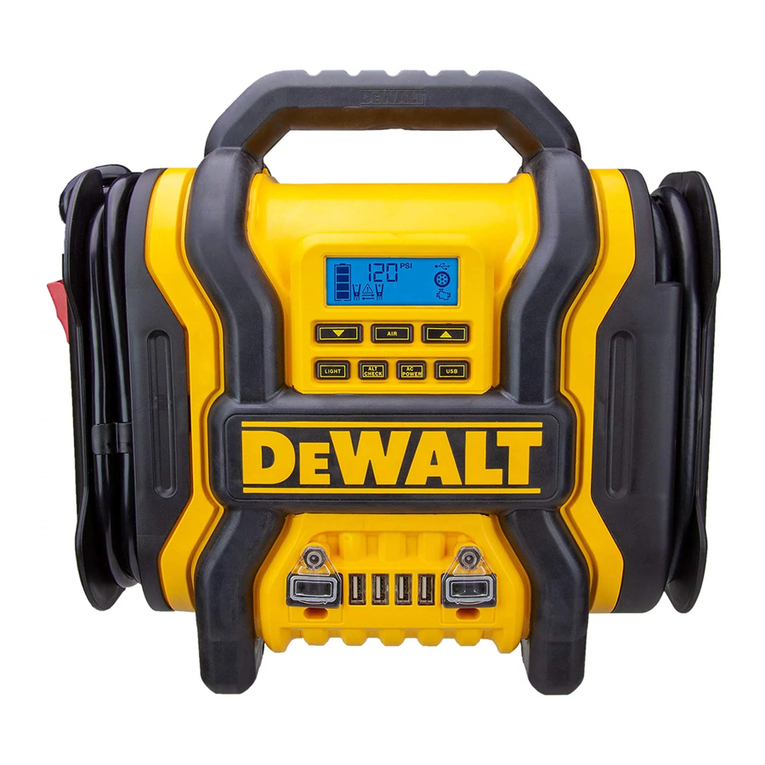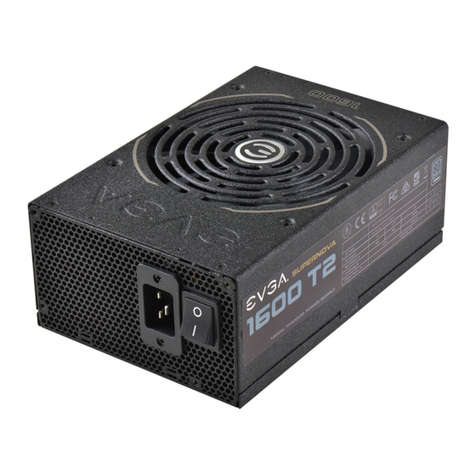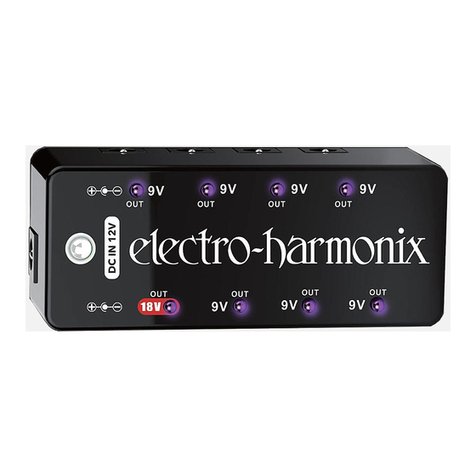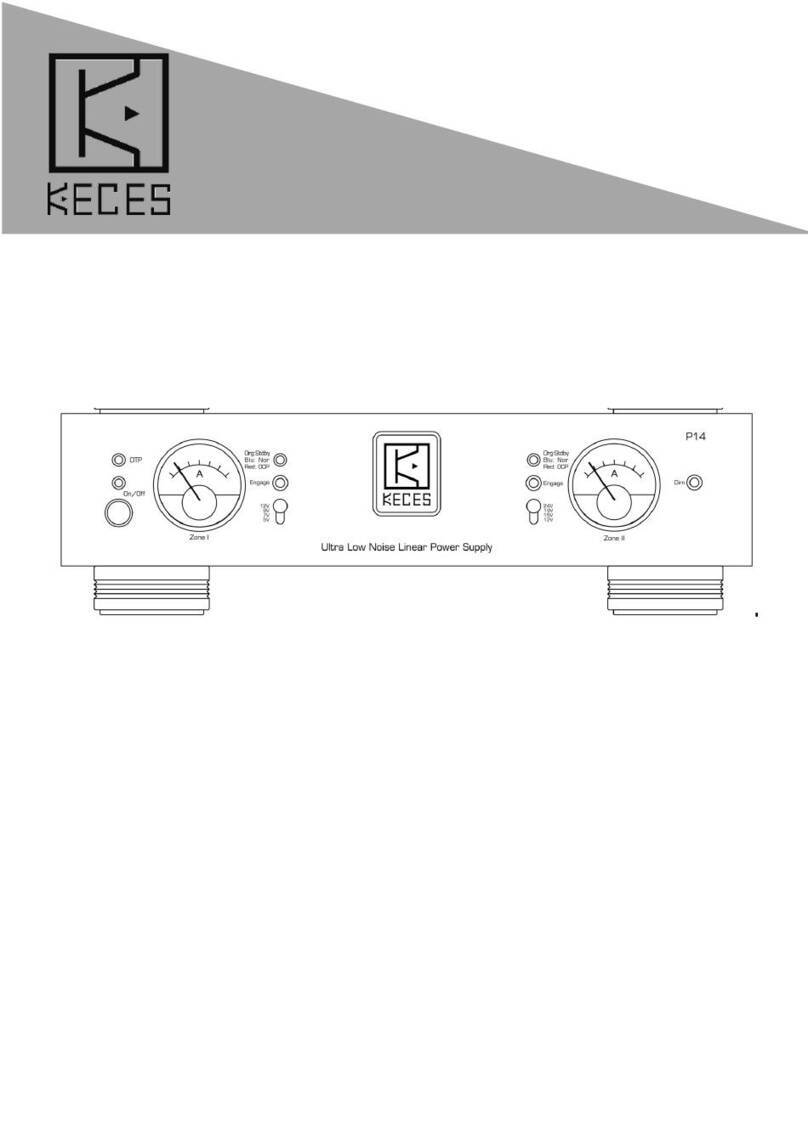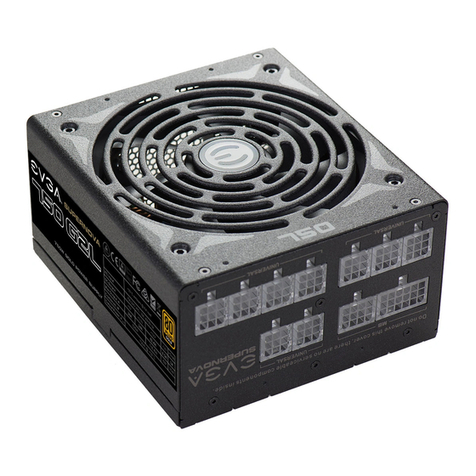Nemic-Lambda TDK-Lambda Genesys GEN6-100 User manual

KARMIEL INDUSTRIAL ZONE, POB 500, ZC-20101,ISRAEL.
TEL: 972-4-9887491 FAX: 972-4-9883321
DECLARATION OF CONFORMITY
We, Nemic-Lambda Ltd., located at Karmiel Industrial zone, Israel, declare under our sole responsibility that the
product:
Product name: Programmable Regulated Power Supplies, Genesys series
TM
Models: GEN6-100
GEN8-90
GEN12.5-60
GEN20-38
GEN30-25
GEN40-19
GEN60-12.5
GEN80-9.5
GEN100-7.5
GEN150-5
GEN300-2.5
GEN600-1.3
GEN6-200
GEN8-180
GEN12.5-120
GEN20-76
GEN30-50
GEN40-38
GEN50-30
GEN60-25
GEN80-19
GEN100-15
GEN150-10
GEN300-5
GEN600-2.6
GENH6-100
GENH8-90
GENH12.5-60
GENH20-38
GENH30-25
GENH40-19
GENH60-12.5
GENH80-9.5
GENH100-7.5
GENH150-5
GENH300-2.5
GENH600-1.3
conforms to the following specifications:
Safety: IEC60950-1:2001, EN60950-1:2001 1st edition
Electromagnetic Emissions:
EN 55024: 1998 A2 (2003)
EN 55022: 1998 A2 (2003)
EN 61000-3-2: 2000
EN 61000-3-3: 1995 Am A1 2001
which cover testing to the following standards:
EN 55022: 1998:A2 2003
EN 55022: 1998:A2 2003
EN 61000-3-2: 2000
EN 61000-3-3: 1995 Am A1 2001
IEC 61000-4-2: 1995
IEC 61000-4-3: 1995
IEC 61000-4-4: 1995
IEC61000-4-5: 1995
IEC 61000-4-6: 1996
IEC 61000-4-8: 1993
IEC 61000-4-11: 1994
Conducted Emissions
Radiated Emissions
Harmonic Emissions
Voltage Fluctuations
ESD
Radiated Immunity
EFT/B
Conductive Surges
Conducted Disturbances
Immunity to Magnetic Field
Voltage Dips
Class A
Class A
Class A
AD: 8KV, CD: 4KV
3V/m
Power leads: 2KV
Signal leads: 0.5KV
Common mode: 2KV
Differential mode: 1KV
3Vrms
1A/m
The product herewith complies with the requirements of the Low Voltage Directive 73/23/EEC, as amended by
93/68/EEC, and the EMC directive 89/336/EEC, as amended by 92/31/EEC and 93/68/EEC for Electrical Equipment used
in Information Technology environments, and carries the CE mark accordingly. Our importer to the EU is Coutant Lambda
Limited , located at Kingsley Avenue, Illfracombe, Devon EX34 8ES, UK. Further , all products covered by this declaration
are manufactured by processes which ensure continued compliance of the products with the requirements of the Low
Voltage and the EMC directives.
Name of Authorized Signatory:
Signature of Authorized Signatory:
Position of Authorized Signatory:
Date:
Place where signed:
Martin Southam
Director of Marketing, Coutant Lambda
12 June 2006
Ilfracombe, UK

This page intentionaly left blank

WARRANTY ..........................................................................................................................................
SAFETY INSTRUCTIONS.....................................................................................................................
GERMAN SAFETY INSTRUCTIONS ...................................................................................................
....................................................................................
1.1 OPERATION MANUAL CONTENT .................................................................................................
1.2 INTRODUCTION .............................................................................................................................
1.2.1 General description ................................................................................................................
1.2.2 Models covered ......................................................................................................................
1.2.3 Features and options .............................................................................................................
1.2.4 Multiple output power system .................................................................................................
1.2.5 Control via the serial communication port ..............................................................................
1.2.6 Analog voltage programming and monitoring .................................................................. ......
1.2.7 Parallel operation ...................................................................................................................
1.2.8 Output connections ................................................................................................................
1.2.9 Cooling and mechanical construction ....................................................................................
1.3 ACCESSORIES ...............................................................................................................................
1.3.1 General ..................................................................................................................................
1.3.2 Serial link cable ......................................................................................................................
1.3.3 Misc. hardware .......................................................................................................................
1.3.4 AC cables ...............................................................................................................................
1.3.5 Serial Port Cables ..................................................................................................................
...................................................................................................
2.1 OUTPUT RATING ...........................................................................................................................
2.2 INPUT CHARACTERISTICS ..........................................................................................................
2.3 CONSTANT VOLTAGE MODE .......................................................................................................
2.4 CONSTANT CURRENT MODE ......................................................................................................
2.5 ANALOG PROGRAMMING AND MONITORING ............................................................................
2.6 PROGRAMMING AND READBACK ...............................................................................................
2.7 PROTECTIVE FUNCTIONS ...........................................................................................................
2.8 FRONT PANEL ................................................................................................................................
2.9 ENVIRONMENTAL CONDITIONS ..................................................................................................
2.10 MECHANICAL ..............................................................................................................................
2.11 SAFETY/EMC ...............................................................................................................................
2.12 SUPPLEMENTAL CHARACTERISTICS .......................................................................................
2.13 OUTLINE DRAWINGS .................................................................................................................
.......................................................................................................
3.1 GENERAL .......................................................................................................................................
3.2 PREPARATION FOR USE ..............................................................................................................
3.3 INITIAL INSPECTION .....................................................................................................................
3.4 RACK MOUNTING ..........................................................................................................................
3.4.1 To install the power supply in a rack .......................................................................................
3.4.2 Rack mount slides ..................................................................................................................
3.5 LOCATION MOUNTING AND COOLING .......................................................................................
3.6 AC SOURCE REQUIREMENTS .....................................................................................................
3.7 AC INPUT POWER CONNECTION ................................................................................................
3.7.1 AC input connector, 1500W models .......................................................................................
3.7.2 AC input connector, 750W models .........................................................................................
3.7.3 AC input cord ..........................................................................................................................
3.7.4 AC input wire connection, 1500W models ..............................................................................
3.8 TURN-ON CHECKOUT PROCEDURE ...........................................................................................
3.8.1 General ...................................................................................................................................
3.8.2 Prior to operation ...................................................................................................................
3.8.3 Constant voltage check ..........................................................................................................
3.8.4 Constant current check ..........................................................................................................
3.8.5 OVP check .............................................................................................................................
3.8.6 UVL check ..............................................................................................................................
3.8.7 Foldback check ......................................................................................................................
3.8.8 Address setting ......................................................................................................................
3.8.9 Baud rate setting ....................................................................................................................
CHAPTER 1 GENERAL INFORMATION
CHAPTER 2 SPECIFICATIONS
CHAPTER 3 INSTALLATION
TABLE OF CONTENTS
Pg.6
Pg.6
Pg.6
Pg.6
Pg.6
Pg.6
Pg.7
Pg.7
Pg.7
Pg.7
Pg.7
Pg.8
Pg.8
Pg.8
Pg.8
Pg.8
Pg.8
Pg.8
Pg.9
Pg.9
Pg.9
Pg.9
Pg.9
Pg.9
Pg.10
Pg.10
Pg.10
Pg.10
Pg.10
Pg.10
Pg.11
Pg.12
Pg.13
Pg.13
Pg.13
Pg.13
Pg.13
Pg.13
Pg.14
Pg.14
Pg.14
Pg.14
Pg.15
Pg.15
Pg.15
Pg.15
Pg.16
Pg.16
Pg.16
Pg.17
Pg.17
Pg.17
Pg.17
Pg.18
Pg.18
Pg.18
Pg.1
Pg.2
Pg.4

3.9 CONNECTING THE LOAD ..........................................................................................................
3.9.1 Load Wiring ..........................................................................................................................
3.9.2 Current Carrying Capacity ...................................................................................................
3.9.3 Wire termination .................................................................................................................
3.9.4 Noise and Impedance Effects ..............................................................................................
3.9.5 Inductive loads .....................................................................................................................
3.9.6 Making the load connections ................................................................................................
3.9.7 Connecting single loads, local sensing (default) ..................................................................
3.9.8 Connecting single loads, remote sensing ............................................................................
3.9.9 Connecting multiple loads, radial distribution method ..........................................................
3.9.10 Multiple loads connection with distribution terminals .........................................................
3.9.11 Grounding outputs .............................................................................................................
3.10 LOCAL AND REMOTE SENSING .............................................................................................
3.10.1 Sensing wiring ...................................................................................................................
3.10.2 Local sensing .....................................................................................................................
3.10.3 Remote sensing .................................................................................................................
3.10.4 J2 sense connector technical information ..........................................................................
3.11 REPACKAGING FOR SHIPMENT .............................................................................................
...............
4.1 INTRODUCTION ..........................................................................................................................
4.2 FRONT PANEL CONTROLS AND INDICATORS ........................................................................
4.3 REAR PANEL ...............................................................................................................................
4.4 REAR PANEL SW1 SETUP SWITCH .........................................................................................
4.4.1 SW1 positions functions ......................................................................................................
4.4.2 Resetting the switch .............................................................................................................
4.5 REAR PANEL J1 PROGRAMMING AND MONITORING CONNECTOR ....................................
4.5.1 Making J1 connections ........................................................................................................
.............................................................................................
5.1 INTRODUCTION ..........................................................................................................................
5.2 STANDARD OPERATION ............................................................................................................
5.2.1 Constant Voltage Mode .......................................................................................................
5.2.2 Constant Current Operation .................................................................................................
5.2.3 Automatic Crossover ............................................................................................................
5.3 OVER VOLTAGE PROTECTION (OVP) ......................................................................................
5.3.1 Setting the OVP level ..........................................................................................................
5.3.2 Activated OVP protection indications ...................................................................................
5.3.3 Resetting the OVP circuit .....................................................................................................
5.4 UNDER VOLTAGE LIMIT (UVL) ..................................................................................................
5.4.1 Setting the UVL level ...........................................................................................................
5.5 FOLDBACK PROTECTION ..........................................................................................................
5.5.1 Setting the Foldback protection ...........................................................................................
5.5.2. Resetting activated Foldback protection ............................................................................
5.6 OUTPUT ON/OFF CONTROL ......................................................................................................
5.7 OUTPUT SHUT-OFF (SO) CONTROL VIA REAR PANEL J1 CONNECTOR ..............................
5.8 ENABLE/DISABLE CONTROL VIA REAR PANEL J1 CONNECTOR ..........................................
5.9 CV/CC SIGNAL .............................................................................................................................
5.10 PS_OK SIGNAL ..........................................................................................................................
5.11 SAFE START AND AUTO-RESTART MODES ............................................................................
5.11.1 Automatic start mode .........................................................................................................
5.11.2 Safe start mode ..................................................................................................................
5.12 OVER TEMPERATURE PROTECTION (OTP) ..........................................................................
5.13 LAST SETTING MEMORY .........................................................................................................
5.14 SERIES OPERATION .................................................................................................................
5.14.1 Series connection for increased output voltage .................................................................
5.14.2 Series connection for positive and negative output voltage ...............................................
5.15 PARALLEL OPERATION ............................................................................................................
5.15.1 Basic parallel operation....................................................................................................
5.15.2 Advanced parallel operation...............................................................................................
CHAPTER 4 FRONT AND REAR PANEL CONTROLS AND CONNECTORS
CHAPTER 5 LOCAL OPERATION
TABLE OF CONTENTS
Pg.18
Pg.18
Pg.18
Pg.19
Pg.20
Pg.20
Pg.20
Pg.23
Pg.23
Pg.23
Pg.24
Pg.24
Pg.25
Pg.25
Pg.25
Pg.26
Pg.26
Pg.26
Pg.27
Pg.27
Pg.27
Pg.29
Pg.30
Pg.31
Pg.31
Pg.32
Pg.32
Pg.34
Pg.34
Pg.34
Pg.34
Pg.34
Pg.35
Pg.35
Pg.35
Pg.35
Pg.35
Pg.36
Pg.36
Pg.36
Pg.36
Pg.36
Pg.36
Pg.36
Pg.37
Pg.37
Pg.37
Pg.38
Pg.38
Pg.38
Pg.38
Pg.38
Pg.38
Pg.39
Pg.40
Pg.41
Pg.41
Pg.41

CHAPTER 6 REMOTE ANALOG PROGRAMMING
CHAPTER 7 RS232 & RS485 REMOTE CONTROL
CHAPTER 8 ISOLATED ANALOG PROGRAMMING OPTION
.................................................................
6.1 INTRODUCTION ...........................................................................................................................
6.2 LOCAL/REMOTE ANALOG CONTROLL.......................................................................................
6.3 LOCAL/REMOTE ANALOG INDICATION......................................................................................
6.4 REMOTE VOLTAGE PROGRAMMING OF OUTPUT VOLTAGE AND CURRENT LIMIT .............
6.5 RESISTIVE PROGRAMMING OF OUTPUT VOLTAGE AND CURRENT LIMIT ...........................
6.6 REMOTE MONITORING OF OUTPUT VOLTAGE AND CURRENT .............................................
...............................................................
7.1 INTRODUCTION ...........................................................................................................................
7.2 CONFIGURATION .........................................................................................................................
7.2.1 Default setting .......................................................................................................................
7.2.2 Address setting .....................................................................................................................
7.2.3 RS232 or RS485 selection ...................................................................................................
7.2.4 Baud rate setting ...................................................................................................................
7.2.5 Setting the unit into Remote or Local mode ..........................................................................
7.2.6 RS232/458 port at Local mode .............................................................................................
7.2.7 Front panel in Remote mode ................................................................................................
7.3 REAR PANEL RS232/485 CONNECTOR ......................................................................................
7.4 CONNECTING POWER SUPPLIES TO RS232 OR RS485 BUS .................................................
7.4.1 Single power supply ..............................................................................................................
7.4.2 Multi power supplies connection to RS232 or RS485 bus ....................................................
7.5 COMMUNICATION INTERFACE PROTOCOL ..............................................................................
7.5.1 Data format ...........................................................................................................................
7.5.2 Addressing ............................................................................................................................
7.5.3 End of message ....................................................................................................................
7.5.4 Command repeat .................................................................................................................
7.5.5 Checksum .............................................................................................................................
7.5.6 Acknowledge .........................................................................................................................
7.5.7 Error message ......................................................................................................................
7.5.8 Backspace ............................................................................................................................
7.6 ERROR MESSAGES .....................................................................................................................
7.7 COMMAND SET DESCRIPTION ..................................................................................................
7.7.1 General guides .....................................................................................................................
7.7.2 Command set categories ......................................................................................................
7.7.3 Initialization control commands .............................................................................................
7.7.4 ID control commands ............................................................................................................
7.7.5 Output control commands .....................................................................................................
7.7.6 Global output commands ....................................................................................................
7.7.7 Status control commands .....................................................................................................
7.8 STATUS, ERROR AND SRQ REGISTERS ...................................................................................
7.8.1 General .................................................................................................................................
7.8.2 Conditional registers .............................................................................................................
7.8.3 Service Request: Enabled and Event Registers ...................................................................
7.9 SERIAL COMMUNICATION TEST SET-UP ..................................................................................
..............................................
8.1 INTRODUCTION ...........................................................................................................................
8.2 SPECIFICATIONS .........................................................................................................................
8.2.1 0-5V/0-10V option .................................................................................................................
8.2.2 4-20mA option .......................................................................................................................
8.3 ISOLATED PROGRAMMING & MONITORING CONNECTOR ....................................................
8.4 SETUP AND OPERATING INSTRUCTIONS .................................................................................
8.4.1 Setting up the power supply for 0-5/0-10V Isolated Programming and Monitoring ...............
8.4.2 Setting up the power supply for 4-20mA Isolated Programming and Monitoring ..................
TABLE OF CONTENTS
Pg.44
Pg.44
Pg.44
Pg.44
Pg.45
Pg.46
Pg.47
Pg.43
Pg.43
Pg.43
Pg.43
Pg.48
Pg.48
Pg.48
Pg.48
Pg.48
Pg.48
Pg.48
Pg.48
Pg.49
Pg.49
Pg.49
Pg.50
Pg.50
Pg.51
Pg.51
Pg.51
Pg.51
Pg.51
Pg.51
Pg.51
Pg.51
Pg.52
Pg.52
Pg.52
Pg.52
Pg.52
Pg.52
Pg.53
Pg.53
Pg.53
Pg.55
Pg.56
Pg.57
Pg.57
Pg.57
Pg.58
Pg.61
Pg.62
Pg.62
Pg.62
Pg.62
Pg.62
Pg.63
Pg.64
Pg.64
Pg.64
5.16 DAISY-CHAIN CONNECTION......................................................................................................
5.17 FRONT PANEL LOCKING.............................................................................................................
5.17.1 Unlocked front panel ............................................................................................................
5.17.2 Locked front panel ...............................................................................................................

This page intentionaly left blank

This Nemic-Lambda product is warranted against defects in materials and workmanship for a period
of five years from date of shipment .During the warranty period, Nemic-Lambda will, at it’s option,
either repair or replace products which prove to be defective.
The warranty shall not apply to defects resulting from improper or inadequate usage or maintenance
by the buyer, buyer supplied products or interfacing. The warranty shall not apply to defects resulting
from unauthorized modifications or from operation exceeding the environmental specifications of
the product or if the QA seal has been removed or altered by anyone other than Nemic-Lambda
authorised personnel. Nemic-Lambda does not warrant the buyers circuitry or malfunctions of
Nemic-Lambda products resulting from the buyer’s circuitry. Furthermore, Nemic-Lambda does not
warrant any damage occurring as a result of the buyer’s circuitry or the buyer’s - supplied products.
This product must be returned to an authorized Nemic-Lambda service facility for repairs or other
warranty service. For products returned to Nemic_Lambda for warranty service, the buyer shall
prepay shipping charges to Nemic-Lambda and Nemic-Lambda shall pay the shipping charges to
return the product to the buyer. Refer to section 3.11 for repackaging for shipment.
The information contained in this document is subject to change without notice. Nemic-Lambda
shall not be liable for errors contained in this document or for incidental or consequential damages in
connection with the furnishing, performance or use of this material. No part of this document may be
photocopied, reproduced or translated into another language without the prior written consent of
Nemic-Lambda.
Microsoft and Windows are trademarks of Microsoft Corporation.
This equipment has been tested and found to comply with the limits for a Class A digital device,
pursuant to Part 15 of the FCC rules. These limits are designed to provide reasonable protection
against harmful interference when the equipment is operated in a commercial environment.
This equipment generates, uses and can radiate radio frequency energy and, if not installed and
used in accordance with the instructions , may cause harmful interference to radio communications.
Operation of this equipment in a residential area is likely to cause harmful interference, in which
case the user will be required to correct the interference at his own expense.
Modifications not expressly approved by manufacturer could void the user authority to operate the
equipment under FCC Rules.
WARRANTY
LIMITATION OF WARRANTY
WARRANTY SERVICE
DISCLAIMER
TRADEMARK INFORMATION
THE FCC WANTS YOU TO KNOW
FCC WARNING
No other warranty is expressed or implied.
TM TM
Genesys power supply is a trademark of Nemic-Lambda & Lambda EMI.
TM
1

SAFETY INSTRUCTIONS
CAUTION
INSTALLATION CATEGORY
GROUNDING
FUSES
INPUT RATINGS
LIVE CIRCUITS
PARTS SUBSTITUTIONS & MODIFICATIONS
The following safety precaution must be observed during all phases of operation, service and repair
of this equipment. Failure to comply with the safety precautions or warnings in this document
violates safety standards of design, manufacture and intended use of this equipment and may
impair the built-in protections within.
Nemic-Lambda shall not be liable for user’s failure to comply with these requirements.
The Genesys power supply series has been evaluated to INSTALLATION CATEGORY II.
Installation category (over voltage category) II: local level, appliances, portable equipment etc.. With
smaller transient over voltage than Installation Category (over voltage category) III.
This product is a Safety Class 1 instrument. To minimize shock hazard, the instrument chassis must
be connected to an electrical ground. The instrument must be connected to the AC power supply
mains through a three conductor power cable, with the ground wire firmly connected to an electrical
ground (safety ground) at the power outlet.
For instruments designed to be hard-wired to the supply mains, the protective earth terminal must
be connected to the safety electrical ground before another connection is made. Any interruption of
the protective ground conductor, or disconnection of the protective earth terminal will cause a
potential shock hazard that might cause personal injury.
There is a potential shock hazard at the RS232/485 and the IEEE ports when using power supplies
with rated or combined voltage greater than 400V and the Positive Output of the Power Supply is
grounded. Do Not connect the Positive Output to ground when using the RS232/485 or IEEE.
Fuses must be changed by authorized Nemic-Lambda service personnel only. For continued
protection against risk of fire, replace only with the same type and rating of fuse. Refer to
maintenance instructions in chapter 9 for fuses rating.
Do not use AC supply which exceeds the input voltage and frequency rating of this instrument. The
input voltage and frequency rating of the Genesys power supply series is:100-240V~, 50/60Hz.
For safety reasons, the mains supply voltage fluctuations should not exceed +/-10% of nominal
voltage.
Operating personnel must not remove the instrument cover. No internal adjustment or component
replacement is allowed by non-Nemic-Lambda qualified personnel. Never replace components with
power cable connected. To avoid injuries, always disconnect power , discharge circuits and remove
external voltage source before touching components.
Parts substitutions and modifications are allowed by authorized Nemic-Lambda service personnel
only. For repairs or modifications, the instrument must be returned to Nemic-Lambda service facility.
TM
TM
WARNING
OUTPUT TERMINAL GROUNDING
2

SAFETY INSTRUCTIONS.
ENVIRONMENTAL CONDITIONS
The Genesys power supply series safety approval applies to the following operating conditions:
*Indoor use *Ambient temperature: 0 C to 50 C
*Maximum relative humidity: 90% (no condensation) *Altitude: up to 3000m
*Pollution degree 2
TM
o o
3
FCC COMPLIANCE NOTICE:
Note: This equipment has been tested and found to comply with the limits for a Class A
digital device, pursuant to part 15 of the FCC Rules. These limits are designed to
provide reasonable protection against harmful interference when the equipment is
operated in a commercial environment. This equipment generates uses, and can
radiate radio frequency energy and, if not installed and used in accordance with the
instruction manual, may cause harmful interference to radio communications.
Operation of this equipment in a residential area is likely to cause harmful interference
in which case the user will be required to correct the interference at his own expense.
!
Instruction manual symbol. The instrument will be marked with this symbol when it is
necessary for the user to refer to the instruction manual.
CAUTION Risk of Electrical Shock.
Indicates hazardous voltage.
Indicates ground terminal.
Protective Ground Conductor Terminal
Off (Supply)
On (Supply)
The WARNING sign denotes a hazard.An attention to a procedure is called.
Not following procedure correctly could result in personal injury.
AWARNING sign should not be skipped and all indicated conditions must be
fully understood and met.
The CAUTION sign denotes a hazard. An attention to a procedure is called. Not
following procedure correctly could result in damage to the equipment. Do not proceed
beyond a CAUTION sign until all indicated conditions are fully understood and met.
WARNING
CAUTION

SICHERHEITS-INSTALLATIONS ANWEISUNGEN
Vorsicht
Betriebsbedingungen
Erdungskonzept
Vorsicht
Absicherung
Anschluss an Versorgungsstromkreis
Spannungsfuhrende Teile
Vor Anschluss an das Netz ist die Aufstellanleitung wie nachstehend beschrieben zu beachten.
Die nachstehenden Sicherheitsanweisungen mussen während aller Phasen des Betriebes, des
Services und der Reparatur dieser Ausrustung beachtet werden. Alle notwendigen Bedingungen
die sicherstellen, dass die Einrichtung zu keiner Gefahr im Sinne dieser Norm fuhren kann, sind
in diesem Handbuch beschrieben.
Nemic-Lambda ist nicht verantwortlich fur Fehler, die bei der Inbetriebnahme des Gerätes auf
Grundlage dieser Sicherheitsanweisungen durch den Betreiber entstehen können.
Die Genesys Stromversorgungs-Reihe ist zur Installation gemäss Uberspannungs-Kategorie 2
entwickelt worden.
Installations Kategorie (Uberspannungs-Kategorie) 2 bedeutet: Kleinindustrie, Geräte,
bewegliche Ausrustung etc.. mit Uberspannungen kleiner als Installation Kategorie 3.
Dieses Produkt ist ein Gerät mit Schutzklasse1. Damit gefährliche Energieinhalte und
Spannungen vermieden werden, ist das Gerätechassis an eine Schutzerde anzuschliessen. Das
Gerät muss an die AC-Wechselspannungsversorgung mit 3 Leitern (L, N, PE) angeschlossen
werden. Der PE-Anschluss ist an einen festen Erder anzuschliessen. Bei Festverdrahtung des
Gerätes ist sicherzustellen, dass der PE Anschluss als erstes durchgefuhrt wird.
Jede mögliche Unterbrechung des PE-Leiters oder Trennung der PE Masse kann einen
möglichen elektrischen Schlag hervorrufen, der Personenschäden zur Folge hätte.
Es besteht Energiegefahr am RS232/485 und IEEE Anschluss, falls die Ausgangsspannung des
Gerätes grösser ist als 400V und der positive Ausgangsanschluss des Netzteiles geerdet wird.
Dies gilt insbesondere auch bei Reihenschaltungen von unterschiedlichen Netzteilen. Wird die
RS232/485 oder IEEE Schnittstelle verwendet, ist darauf zu achten, dass der
Plus-Ausgangsanschluss nicht geerdet wird.
Sicherungen durfen nur durch autorisierte Nemic-Lambda Service Personen ausgetauscht
werden. Um Brandgefahr vorzubeugen, sind nur Sicherungen zu verwenden mit gleicher Bauart
und Auslösecharakteristik. Siehe hierzu Wartungsanweisungen in Kapitel 9 bezuglich
Sicherungen.
Der Betrieb des Gerätes ist nur fur den dafur spezifizierten Wechselspannungsbereich und der
angegebenen Frequenz erlaubt.
Der Nominaleingangsspannungsbereich der Genesys Serie liegt bei 100-240VAC mit
50/60Hz. Fur einen sicheren Betrieb des Gerätes ist eine Abweichung von max. +/-10% der
Nominalspannung erlaubt.
Die Geräteabdeckung darf nur im stromlosen Zustand geöffnet werden. Interne Modifikationen,
sowie Bauteileaustausch ist nur durch Nemic-Lambda qualifiziertes Personal erlaubt. Vor
Austausch von Bauteilen ist das Netzkabel bzw. die Versorgungsspannung zu trennen.
Energieversorgungsanschlusse sind immer zu trennen um Personenverletzungen durch
gefährliche Energieinhalte und Spannungen auszuschliessen. Die Stromkreise sind zu entladen,
externe Spannunsquellen sind zu entfernen bevor Bauteile bzw. Komponenten getauscht werden.
TM
TM
Erdung des DC-Ausgangs
4
!

5
Anderungen und Bauteileersatz
Umweltbedingungen
Sicherheits- und Warnsymbole
Ersatzteilaustausch - und Anderungen durfen nur von autorisiertem Nemic-Lambda SERVICE-
PERSONEN durchgefuhrt werden. Fur Reparaturen oder Anderungen ist das Gerät zur Nemic-
Lambda Service-Niederlassung zu retournieren.
Die Genesys -Stromversorgungs-Serie ist gemäss den Sicherheitsabnahmen fur folgende
Betriebsbedingungen zugelassen.
* Stationäre Einrichtungen in Gebäuden.
* Umgebungstemperaturbereich: 0-50 C.
* Maximale Relative Luftfeuchtigkeit: 90% (nicht kondensierend).
* Betriebshöhe: bis zu 3000m.
* Verschmutzungsgrad 2.
VORSICHT Spannungsfuhrende Teile - Gefahr durch elektrischen Schlag bzw. Energieinhalte.
Handbuch-Symbol. Das Gerät bzw. Geräteteile werden mit diesem Symbol gekennzeichnet,
wenn es fur den Benutzer notwendig ist, sich auf die Anweisungen im Handbuch zu beziehen.
Zeigt "spannungsfuhrende Teile" mit gefährlicher Spannung an.
Zeigt Masse-Anschluss an, keine Schutzerde.( z.B. Masseanschluss an einen Verbraucher).
Schutzleiter-Anschlussklemme.
Symbol fur Schalter oder Druckknöpfe - Zeigt die "Ein"- Stellung hier an.
Symbol fur Schalter oder Druckknöpfe - Zeigt die "Aus"-Stellung hier an.
Dieses Warnaufschrift weist auf eine Gefahr hin, die eine Uberprufunganweisung nach
sich zieht. Nichteinhaltung kann zu Personenschäden fuhren.
Dieser Warnhinweis darf nicht ubersprungen werden und die beschriebene Vorgehensweise muss
strikt verstanden werden und dementsprechend umgesetzt werden.
Diese "Vorsichtswarnung" weist auf eine Gefahr hin, die einer Vorkehrung bedarf.
Nichteinhaltung kann zur Zerstörung der Anlage oder des Gerätes fuhren. Bitte berucksichtigen
Sie Anweisungen, die dort beschrieben sind, bevor Sie mit Benutzung der Anlage bzw. des
Gerätes fortfahren.
SICHERHEITS-HINWEISE
TM
o
alle
WARNING
CAUTION
!
MASCHINENLAERM
Maschinenlaerminformations Verordnung 3. GPSGV, der hoechste Schalldruckpegel betraegt
70 dB A) oder weniger gemass EN ISO 7779.
– –
(

CHAPTER 1 GENERAL INFORMATION
1.1 USER MANUAL CONTENT
1.2 INTRODUCTION
This user’s manual contains the operating instructions, installation instructions and specifications of
the Genesys 1500W and 750W power supply series. The instructions refer to the standard power
supplies, including the built-in RS232/485 serial communication. For information related to
operation with the optional IEEE programming, refer to User Manual for Power Supply IEEE
Programming Interface.
Genesys power supplies are wide output range, high performance switching power supplies. The
Genesys series is power factor corrected and operates from worldwide AC voltage range
continuously . Output voltage and current are continuously displayed and LED indicators show the
complete operating status of the power supply. The Front panel controls allow the user to set the
output parameters, the protection levels (Over-Voltage protection, Under-Voltage limit and
Foldback) and preview the settings. The rear panel includes the necessary connectors to control
and monitor the power supply operation by remote analog signals or by the built-in serial
communication (RS232/485). GPIB programming and Isolated-Analog programming/monitoring
are optional.
Model Voltage Current Model Voltage Current
range(V) range(A) range(V) range(A)
GEN6-100 0-6 0-100 GEN60-12.5 0-60 0-12.5
GEN6-200 0-6 0-200 GEN60-25 0-60 0-25
GEN8-90 0-8 0-90 GEN80-9.5 0-80 0-9.5
GEN8-180 0-8 0-180 GEN80-19 0-80 0-19
GEN12.5-60 0-12.5 0-60 GEN100-7.5 0-100 0-7.5
GEN12.5-120 0-12.5 0-120 GEN100-15 0-100 0-15
GEN20-38 0-20 0-38 GEN150-5 0-150 0-5
GEN20-76 0-20 0-76 GEN150-10 0-150 0-10
GEN30-25 0-30 0-25 GEN300-2.5 0-300 0-2.5
GEN30-50 0-30 0-50 GEN300-5 0-300 0-5
GEN40-19 0-40 0-19 GEN600-1.3 0-600 0-1.3
GEN40-38 0-40 0-38 GEN600-2.6 0-600 0-2.6
GEN50-30 0-50 0-30
Table1-1: Models covered by the manual
Constant Voltage / Constant Current with automatic crossover.
* Active Power Factor correction.
* Universal Input Voltage 85~265Vac, continuous operation.
* Embedded Microprocessor Controller.
* Built in RS232/485 Interface.
* Voltage & Current high resolution adjustment by digital encoders.
* High accuracy programming/readback-16 bit.
* Software Calibration (no internal trimmers / potentiometers).
* Last Setting Memory.
* Independent Remote ON/OFF (opto-isolated) and Remote Enable/Disable.
TM
TM
TM
1.2.1 General description
1.2.2 Models covered by this manual
1.2.3 Features and options
*
6

* Parallel operation (Master/Slave) with Active current sharing.
* Remote sensing to compensate for voltage drop of power leads.
* Cooling fan speed control for low noise and extended fan life.
* Zero stacking- no ventillation holes at the top and bottom surface of the power supply.
* Optional GPIB interface (SCPI compatible).
* Optional Isolated Analog programming/monitoring (0-5V or 0-10V, user selectable
and 4-20mA).
The Genesys power supplies series can be configured into a programmable power
system of up to 31 units using the built-in RS232/RS485 communication port in the power
supply and the RS485 linking cable provided with each power supply.
In a GPIB system, each power supply can be controlled using the optional GPIB controller
(factory installed).
The following parameters can be programmed via the serial communication port:
1. Output voltage setting.
2. Output current setting.
3. Output voltage measurement.
4. Output on/off control.
5. Output current measurement.
6. Foldback protection setting.
7. Over-voltage protection setting and readback.
8. Under-Voltage limit setting and readback.
9. Power-supply start up mode (last setting or safe mode)
Analog inputs and outputs are provided at the rear panel for analog control of the power
supply. The output voltage and the current limit can be programmed by analog voltage or by
resistor, and can be monitored by analog voltage. The power supply output can be remotely
set to On or Off and analog signals monitor the proper operation of the power supply and the
mode of operation (CV/CC).
Genesys power supplies of the same output voltage and current rating can be paralleled in
master-slave configuration with automatic current sharing to increase power available.
Output connections are made to rear panel bus-bars for models up to 60V and to a 4-
terminal wire clamp connector for models above 60V rated output voltage. Either the
positive or negative terminal may be grounded or the output may be floated. Models up to
60VDC Rated Output shall not float outputs more than +/- 60VDC above/below chassis
ground. Models >60VDC Rated Output shall not float outputs more than +/-600VDC
above/below chassis ground. Contact factory for assistance with higher float voltage
applications.
Local or remote sense may be used. In remote sense, the voltage drop on the load wires
should be minimized. Refer to the specifications for the maximum voltage drop value.
* External Analog Programming and Monitoring standard (0-5V or 0-10V, user selectable).
1.2.4 Multiple output power system
1.2.5 Control via the serial communication port
1.2.6 Analog voltage programming and monitoring
1.2.7 Parallel operation
TM
TM
1.2.8 Output connections
7

1.2.9 Cooling and mechanical construction
1.3.1 General
1.3.2 Serial link cable
1.3.4 AC cables
The Genesys series is cooled by internal fans. At the installation, care must be taken to
allow free air flow into the power supply via the front panel and out of the power supply via
the rear panel. The Genesys power supplies have a compact and lightweight package
which allows easy installation and space saving in the application equipment.
Accessories are delivered with the power supply or separately upon ordering. The list below
shows the possible accessories and ordering numbers.
S
TM
TM
1.3 ACCESSORIES
erial link cable, for linking power supplies by RS485 communication is provided with the
power supply.
Cable description: 0.5m length, shielded, RJ-45 type plugs, 8 contacts (P/N: GEN/RJ45).
* DB25 plug kit (AMP, 749809-9).
* Output terminal shield
AC cables are not provided with the power supply. If an AC cable is required, it should be
ordered according to following:
Part no. Market Description
NC301 USA 13A125V, unshielded, 2m typical length, with IEC320 connector on
one end and NEMA-5-15P connector on the other end.
NC302 Europe 10A 250V, unshielded, 2m typical length, with IEC320 connector
on one end and INT’L 7 standard VII, dual earthing.
NC303 General 10A 250V, unshielded, 2m typical length, with IEC320 connector
on one end and unterminated stripped wires on the other end.
Use the cable only with plug approved by the national safety
standards of the country of usage.
NC305 Japan 13A 125V, unshielded, 2m typical length, with IEC320 connector
on one end and Japan type plug on the other end.
NC306 UK 10A 250V unshielded, 2m typical length, with IEC320 connector
on one end and UK type plug on the other end.
For 1500W Genesys power supplies the recommended AC cable (customer supplied) is:
25A 250V, 3x12AWG, outer diameter: 9-11mm, rated 60 C min.,
3m max. length. Add a non-locking plug approved by the national
safety standards of the country of usage.
Refer to section 7.4
1.3.3 Misc. hardware
1.3.5 Serial Port Cables
TM
O
8
(GEN/U)
(GEN/E)
(GEN/O)
(GEN )/J
(GEN/GB)
Observe all torque guidelines within this manual. Over torqueing may damage
unit or accessories. Such damage is not covered under manufacturers warranty.
CAUTION
CHAPTER 2 SPECIFICATIONS
2.1 OUTPUT RATING
2.2 INPUT CHARACTERISTICS
1.Input voltage/freq.(*3)
2.Input current (at 100/200Vac)
3.Power Factor
4.750W models Efficiency (*4)
5.1500W models Efficiency (*4)
6.Inrush current at 100/200V
---
A
---
%
%
A
85~265Vac continuous , 47~63Hz,single phase.
10.5/5 for 750W models, 21/11 for 1500W models.
0.99@100/200Vac , rated output power.
Less than 25A for 750W models, 50A for 1500W models.
V6 8 12.5 20 30 40 50 60 80 100 150 300 600
76/78
77/79
77/80
78/81
81/84
82/85
82/85
83/86
82/85
83/86
83/87
84/88
83/87
84/88
-
84/88
83/87
84/88
83/87
84/88
83/87
84/88
83/87
84/88
83/87
84/88
1.Vout voltage programming
2.Iout voltage programming
3.Vout resistor programming
4.Iout resistor programming
5.On/off control
6.Output current monitor
7.Output voltage monitor
8.Power supply OK signal
9.Parallel operation
10.Series operation
11.CV/CC indicator
12.Enable/Disable
13.Local/Remote analog control
14.Local/Remote analog indicator
---
---
---
---
---
---
---
---
---
---
---
---
---
---
0~100%, 0~5V or 0~10V, user select. Accuracy and linearity: +/-0.5% of rated Vout.
0~100%, 0~5V or 0~10V, user select. Accuracy and linearity: +/-1% of rated Iout.
0~100%, 0~5/10Kohm full scale, user select. Accuracy and linearity: +/-1% of rated Vout.
0~100%, 0~5/10Kohm full scale, user select. Accuracy and linearity: +/-1.5% of rated Iout.
By electrical Voltage: 0~0.6V/2~15V or dry contact, user selectable logic.
0~5V or 0~10V, user selectable. Accuracy: 1%.
0~5V or 0~10V, user selectable. Accuracy : 1%.
4~5V-OK, 0V-Fail. 500ohm series resistance.
Possible , up to 4 units in master/slave mode with single wire current balance connection.
Possible (with external diodes), up to 2 units.
CV: TTL high (4~5V), source current: 10mA, CC: TTL low (0~0.6V), sink current: 10mA.
Dry contact. Open: off, Short: on. Max. voltage at Enable/Disable in: 6V.
By electrical signal or Open/Short: 0~0.6V or short: Remote, 4~5V or open: Local.
Open collector. Local: Open, Remote: On. Maximum voltage: 30V, maximum sink current: 5mA.
2.3 CONSTANT VOLTAGE MODE
1.Max. Line regulation (*5)
2.Max Load regulation (*6)
3.Ripple and noise (p-p , 20MHz) (*10)
4.Ripple r.m.s., 5Hz~1MHz (*10)
5.Temperature coefficient
6.Temperature drift
7.Rem. sense compensation/wire
8.Up-prog. response time, 0~Vomax(*9)
9.Down-prog. response time: Full load
No load
10.Transient response time
11.Hold-up time
V6 8 12.5 20 30 40 50 60 80 100 150 300 600
---
---
mV
mV
---
V
mS
mS
mS
mS
PPM/C
0.01% of rated output voltage +2mV
0.01% of rated output voltage +2mV
60
8
60
8
60
8
60
8
60
8
60
8
60
8
60
8
80
8
80
8
100
10
150
25
300
60
100PPM/ from rated output voltage, following 30 minutes warm-up.
0.05% of rated Vout over 8hrs interval following 30 minutes warm-up. Constant line, load & temp.
OC
1111 1.5 2 23 4 5 5 5 5
80 150
10 50 80 150
500 600 700 800 900 1000 1500 2000 2500 4000
More than 20mS, 100Vac, rated output power.
1100
1100 1200
Time for the output voltage to recover within 0.5% of its rated output for a load change 10~90% of rated
output current.
Output set-point: 10~100%.
Less than 1mS, for models up to and including 100V. 2mS, for models above 100V.
250
250
1.Rated output voltage(1*)
2.Rated output current 1500W (*2)
3.Rated output power 1500W
1.Rated output voltage (1*)
2.Rated output current 750W (*2)
3.Rated output power 750W
V
A
W
A
W
6
200
1200
100
600
8
180
1440
90
12.5
120
1500
60
750
20
76
1520
38
760
30
50
1500
25
750
40
38
1520
19
760
50
30
1500
-
-
60
25
1500
12.5
750
80
19
1520
9.5
760
100
15
1500
7.5
750
150
10
1500
5
750
300
5
1500
2.5
750
600
2.6
1560
1.3
780
MODEL GEN 6-200 8-180 12.5-120 20-76 30-50 40-38 50-30 60-25 80-19 100-15 150-10 300-5 600-2.6
V6812.5 20 30 40 -60 80 100 150 300 600
MODEL GEN 6-100 8-90
12.5-60
20-38 30-25 40-19 -60-12.5 80-9.5 100-7.5 150-5 300-2.5 600-1.3
2.5 ANALOG PROGRAMMING AND MONITORING
V6 8 12.5 20 30 40 50 60 80 100 150 300 600
2.4 CONSTANT CURRENT MODE
1.Max. Line regulation (*5)
2.Max. Load regulation (*7)
3.Ripple r.m.s. 5Hz~1MHz: 750W (*8)
1500W (*8)
4.Temperature coefficient
5.Temperature drift
6. Warm up drift
---
---
---
---
mA
mA
PPM/C
0.01% of rated output current +2mA
0.02% of rated output current +5mA
100PPM/ C from rated output current, following 30 minutes warm-up.
0.05% of rated Iout over 8hrs interval following 30 minutes warm-up. Constant line, load & temp.
Less than 0.1% rated output current over 30 minutes following power on or output voltage change or load
current change.
O
200
400
180
360
120
240
76
152
63
125
48
95
38
75
-
85
29
57
23
45
18
35
13
25
8
12
9
720

CHAPTER 2 SPECIFICATIONS
2.1 OUTPUT RATING
2.2 INPUT CHARACTERISTICS
1.Input voltage/freq.(*3)
2.Input current (at 100/200Vac)
3.Power Factor
4.750W models Efficiency (*4)
5.1500W models Efficiency (*4)
6.Inrush current at 100/200V
---
A
---
%
%
A
85~265Vac continuous , 47~63Hz,single phase.
10.5/5 for 750W models, 21/11 for 1500W models.
0.99@100/200Vac , rated output power.
Less than 25A for 750W models, 50A for 1500W models.
V6 8 12.5 20 30 40 50 60 80 100 150 300 600
76/78
77/79
77/80
78/81
81/84
82/85
82/85
83/86
82/85
83/86
83/87
84/88
83/87
84/88
-
84/88
83/87
84/88
83/87
84/88
83/87
84/88
83/87
84/88
83/87
84/88
1.Vout voltage programming
2.Iout voltage programming
3.Vout resistor programming
4.Iout resistor programming
5.On/off control
6.Output current monitor
7.Output voltage monitor
8.Power supply OK signal
9.Parallel operation
10.Series operation
11.CV/CC indicator
12.Enable/Disable
13.Local/Remote analog control
14.Local/Remote analog indicator
---
---
---
---
---
---
---
---
---
---
---
---
---
---
0~100%, 0~5V or 0~10V, user select. Accuracy and linearity: +/-0.5% of rated Vout.
0~100%, 0~5V or 0~10V, user select. Accuracy and linearity: +/-1% of rated Iout.
0~100%, 0~5/10Kohm full scale, user select. Accuracy and linearity: +/-1% of rated Vout.
0~100%, 0~5/10Kohm full scale, user select. Accuracy and linearity: +/-1.5% of rated Iout.
By electrical Voltage: 0~0.6V/2~15V or dry contact, user selectable logic.
0~5V or 0~10V, user selectable. Accuracy: 1%.
0~5V or 0~10V, user selectable. Accuracy : 1%.
4~5V-OK, 0V-Fail. 500ohm series resistance.
Possible , up to 4 units in master/slave mode with single wire current balance connection.
Possible (with external diodes), up to 2 units.
CV: TTL high (4~5V), source current: 10mA, CC: TTL low (0~0.6V), sink current: 10mA.
Dry contact. Open: off, Short: on. Max. voltage at Enable/Disable in: 6V.
By electrical signal or Open/Short: 0~0.6V or short: Remote, 4~5V or open: Local.
Open collector. Local: Open, Remote: On. Maximum voltage: 30V, maximum sink current: 5mA.
2.3 CONSTANT VOLTAGE MODE
1.Max. Line regulation (*5)
2.Max Load regulation (*6)
3.Ripple and noise (p-p , 20MHz) (*10)
4.Ripple r.m.s., 5Hz~1MHz (*10)
5.Temperature coefficient
6.Temperature drift
7.Rem. sense compensation/wire
8.Up-prog. response time, 0~Vomax(*9)
9.Down-prog. response time: Full load
No load
10.Transient response time
11.Hold-up time
V6 8 12.5 20 30 40 50 60 80 100 150 300 600
---
---
mV
mV
---
V
mS
mS
mS
mS
PPM/C
0.01% of rated output voltage +2mV
0.01% of rated output voltage +2mV
60
8
60
8
60
8
60
8
60
8
60
8
60
8
60
8
80
8
80
8
100
10
150
25
300
60
100PPM/ from rated output voltage, following 30 minutes warm-up.
0.05% of rated Vout over 8hrs interval following 30 minutes warm-up. Constant line, load & temp.
OC
1111 1.5 2 23 4 5 5 5 5
80 150
10 50 80 150
500 600 700 800 900 1000 1500 2000 2500 4000
More than 20mS, 100Vac, rated output power.
1100
1100 1200
Time for the output voltage to recover within 0.5% of its rated output for a load change 10~90% of rated
output current.
Output set-point: 10~100%.
Less than 1mS, for models up to and including 100V. 2mS, for models above 100V.
250
250
1.Rated output voltage(1*)
2.Rated output current 1500W (*2)
3.Rated output power 1500W
1.Rated output voltage (1*)
2.Rated output current 750W (*2)
3.Rated output power 750W
V
A
W
A
W
6
200
1200
100
600
8
180
1440
90
12.5
120
1500
60
750
20
76
1520
38
760
30
50
1500
25
750
40
38
1520
19
760
50
30
1500
-
-
60
25
1500
12.5
750
80
19
1520
9.5
760
100
15
1500
7.5
750
150
10
1500
5
750
300
5
1500
2.5
750
600
2.6
1560
1.3
780
MODEL GEN 6-200 8-180 12.5-120 20-76 30-50 40-38 50-30 60-25 80-19 100-15 150-10 300-5 600-2.6
V6812.5 20 30 40 -60 80 100 150 300 600
MODEL GEN 6-100 8-90
12.5-60
20-38 30-25 40-19 -60-12.5 80-9.5 100-7.5 150-5 300-2.5 600-1.3
2.5 ANALOG PROGRAMMING AND MONITORING
V6 8 12.5 20 30 40 50 60 80 100 150 300 600
2.4 CONSTANT CURRENT MODE
1.Max. Line regulation (*5)
2.Max. Load regulation (*7)
3.Ripple r.m.s. 5Hz~1MHz: 750W (*8)
1500W (*8)
4.Temperature coefficient
5.Temperature drift
6. Warm up drift
---
---
---
---
mA
mA
PPM/C
0.01% of rated output current +2mA
0.02% of rated output current +5mA
100PPM/ C from rated output current, following 30 minutes warm-up.
0.05% of rated Iout over 8hrs interval following 30 minutes warm-up. Constant line, load & temp.
Less than 0.1% rated output current over 30 minutes following power on or output voltage change or load
current change.
O
200
400
180
360
120
240
76
152
63
125
48
95
38
75
-
85
29
57
23
45
18
35
13
25
8
12
9
720

2.6 PROGRAMMING AND READBACK (RS232/485, Optional IEEE Interface)
1.Vout programming accuracy
2.Iout programming accuracy
3.Vout programming resolution
4.Iout programming resolution
5.Vout readback accuracy
6.Iout readback accuracy
7.Vout readback resolution
8.Iout readback resolution
---
---
---
---
---
---
---
---
0.05%+0.05% of rated output voltage
0.1%+0.1% of rated output current
0.012% of full scale
0.012% of full scale
0.1%+0.1% of rated output voltage
0.1%+0.3% of rated output current
0.012% of full scale
0.012% of full scale
2.7 PROTECTIVE FUNCTIONS
1.Foldback protection
2.Over-voltage protection
3.Over-voltage trip point
4.Output under voltage limit
5.Over temperature protection
V6 8 12.5 20 30 40 50 60 80 100 150 300 600
---
---
---
---
V
Output shut-down when power supply change from CV to CC User presetable.
Inverter shut-down, manual reset by AC input recycle or by OUT button or by communication port command.
Preset by front panel or communication port. Prevents from adjusting Vout below limit.
User selectable, latched or non latched.
0.5~7.5 0.5~10 1~15 1~24 2~36 2~44 5~66
5~57 5~88 5~110 5~165 5~330 5~660
2.8 FRONT PANEL
---
---
---
---
---
---
---
---
---
---
---
---
---
Vout/Iout manual adjust by separate encoders (coarse and fine adjustment).
OVP/UVL manual adjust by Vout. Adjust encoder.
Address selection by Voltage Adjust encoder. No of addresses:31.
Go to local control.
Output on/off
AC on/off
Front panel Lock
Foldback control
Baud rate selection: 1200, 2400, 4800, 9600 and 19200.
Re-start modes (automatic restart, safe mode).
Vout: 4 digits, accuracy: 0.5%+/-1count.
Iout: 4 digits, accuracy: 0.5%+/-1count.
VOLTAGE, CURRENT, ALARM, FINE, PREVIEW, FOLDBACK, LOCAL, OUTPUT ON.
1.Control functions
2.Display
3.Indications
2.9 ENVIRONMENTAL CONDITIONS
1.Operating temperature
2.Storage temperature
3.Operating humidity
4.Storage humidity
5.Altitude
---
---
%
%
---
0~50 C, 100% load.
-20~70 C
30~90% RH (no condensation).
10~95% RH (no condensation).
Maximum 3000m. Derate output current by 2%/100m above 2000m. Alternatively, derate maximum
ambient temperature by 1 C/100m above 2000m.
o
o
O
2.10 MECHANICAL
1.Cooling
2.Weight
3.Dimensions (WxHxD)
4.Vibration
5.Shock
---
Kg
mm
---
---
Forced air cooling by internal fans.
Less than 7Kg for 750W, 8.5Kg for 1500W.
W: 422.8, H: 43.6, D: 432.8 (Refer to Outline drawing).
MIL-810E, method 514.4, test condition I-3.3.1
Less than 20G, half sine, 11mS. Unit is unpacked.
UL60950-1 listed, EN60950-1. Vout<40V: Output is SELV, IEEE/isolated analog are SELV.
40<Vout<400V: Output is hazardous, IEEE/isolated analog are SELV.
400<Vout<600V: Output is hazardous, IEEE/isolated analog are not SELV.
EN55024
Vout< 40V models: Input-Outputs (SELV): 3.0KVrms 1min, Input-Ground: 2.0KVrms 1min ,
40<Vout<600V models: Input-Haz. Output: 2.5KVrms 1min, Input-SELV: 3KVrms 1min ,
Hazardous Output-SELV: 1.9KVrms 1min, Hazardous Output-Ground: 1.9KVrms 1min,
Input-Ground: 2KVrms 1min.
More than 100Mohm at 25 C, 70%RH.
EN55022B, FCC part 15-B, VCCI-B
EN55022A, FCC part 15-A, VCCI-A
o
2.11 SAFETY/EMC
2.Withstand voltage
3.Insulation resistance
4.Conducted emmision
5.Radiated emission
1.Applicable standards: Safety ---
---
---
---
---
---
EMC
10

11
*1: Minimum voltage is guaranteed to maximum 0.2% of the rated output voltage.
*2: Minimum current is guaranteed to maximum 0.4% of the rated output current.
*3: For cases where conformance to various safety standards (UL, IEC etc.) is required, to be
described as 100-240Vac (50/60Hz).
*4: At 100/200V input voltage and maximum output power.
*5: From 85~132Vac or 170~265Vac, constant load.
*6: From No-load to Full-load, constant input voltage. Measured at the sensing point in Remote
Sense.
*7: For load voltage change, equal to the unit voltage rating, constant input voltage.
*8: For 6V models the ripple is measured at 2~6V output voltage and full output current. For
other models, the ripple is measured at 10~100% output voltage and full output current.
*9: With rated, resistive load.
*10:For 6V~300V models: Measured with JEITA RC-9131A (1:1) probe.
For 600V model: Measured with (10:1) probe.
The supplemental characteristics give typical but non-warranted performance characteristics.
The supplemental characteristics are useful in assessing applications for the power supply.
Several kinds of supplemental characteristics are listed below.
1.Evaluation Data: Typical performance of the power supply.
2.Reliability Data: Reliability performance of the power supply.
3.IEC1000 Data: Performance of the power supply under IEC1000 test conditions.
4.EMI Data: Typical EMI (conducted and radiated) performance of the power supply.
The supplemental characteristics data is held in each Lambda sales and service facility. For further
details please contact the Lambda office nearest you.
NOTES:
2.12 SUPPLEMENTAL CHARACTERISTICS

12
2.13 GENESYS 750W & 1500W POWER SUPPLIES
OUTLINE DRAWINGS
TM
482.8+/-1.0mm
43.6+/-0.3mm
AA A
507.0+/-1.0mm
57.8+/-0.5 92.0+/-0.5 92.0+/-0.5
21.0
433+/-1.0mm
J2
AC INPUT
ON
OFF OUT IN
J3
J1
SW1
422.8+/-1.0mm
Note 1
Note 5 Note 2
NOTES:
1.Mating plug supplied with power supply.
2.Bus-bars for 6V to 60V models. See detail.
Wire clamp connector for 80V to 600V models (shown).
3. AC cable strain relief for 1500W models only (supplied
with power supply).
4. IEC connector for 750W models. Wire clamp terminal for
1500W models (shown).
5. Chassis slides mounting holes #10-32 marked "A".
GENERAL DEVICES P/N: CC3001-00-S160 or
equivalent.
104+/-2.0mm
Note 4
Note 3
39.5+0.5mm
22.0mm
3.0mm
30.0mm
Bus-Bar Detail
6V to 60V Models
8.5mm
T
D
Lam
b
da
-
I
T
D
L
am
b
da
-
I

CHAPTER 3 INSTALLATION
3.1 GENERAL
3.2 PREPARATION FOR USE
3.3 INITIAL INSPECTION
3.4 RACK MOUNTING
This chapter contains instructions for initial inspection, preparation for use and repackaging for
shipment. Connection to PC, setting the communication port and linking Genesys power supplies
are described in Chapter 7.
Genesys power supplies generate magnetic fields which
might affect the operation of other instruments. If your
equipment is susceptible to magnetic fields, do not position
it adjacent to the power supply.
n order to be operational the power supply must be connected to an appropriate AC source. The
AC source voltage should be within the power supply specification. Do not apply power before
reading, Section 3.6 and 3.7.
Table 3-1 below, describes the basic setup procedure. Follow the instructions in Table 3-1 in the
sequence given to prepare the power supply for use.
Step no. Item Description Reference
Prior to shipment this power supply was inspected and found free of mechanical or electrical
defects. Upon unpacking of the power supply, inspect for any damage which may have occured in
transit.
The inspection should confirm that there is no exterior damage to the power supply such as broken
knobs or connectors and that the front panel and meters face are not scratched or cracked. Keep all
packing material until the inspection has been completed. If damage is detected, file a claim with
carrier immediately and notify the Lambda sales or service facility nearest you.
The Genesys power supply series is designed to fit in a standard 19” equipment rack.
1. Use the front panel rack-mount brackets to install the power supply in the rack.
2. Use a support bar to provide adequate support for the rear of the power supply. Do not obstruct
the air exhaust at the rear panel of the unit.
TM
TM
TM
I
3.4.1 To install the Power Supply in a rack:
13
NOTE
1
2
3
4
5
6
Inspection
Installation
AC source
Test
Load connection
Default setting
Initial physical inspection of the power supply Section 3.3
Installing the power supply,
Ensuring adequate ventillation.
AC source requirements
Connecting the power supply to the AC source.
Turn-on checkout procedure.
The power supply setting at shipment.
Wire size selection. Local /Remote sensing.
Single or multiple loads.
Section 3.4
Section 3.5
Section 3.6
Section 3.7
Section 3.8
Section 3.9
Section 7.2.1
Table 3-1: Basic setup procedure

3.4.2 Rack Mount Slides (optional):
Use rack mount slides: General Devices P/N: CC3001-00-S160 (ordering P/N: C-300-S-116-RH-
LH) or equivalent to install the unit in a standard 19” equipment rack. Refer to Fig. 3-1 for slides
assembly instructions. Use three #10-32x0.38"(max.) screws at each side. To prevent internal
damage, use the specified screw length only.
This power supply is fan cooled. The air intake is at the front panel and the exhaust is at the rear
panel. Upon installation allow cooling air to reach the front panel ventilation inlets. Allow minimum
10cm (4 Inch) of unrestricted air space at the front and the rear of the unit.
The power supply should be used in an area that the ambient temperature does not exceed +50 C.
The Genesys series can be operated from a nominal 100V to 240V, single phase, 47~63Hz. The
input voltage range and current required for each model is specified in Chapter 2. Ensure that under
heavy load, the AC voltage supplied to the power supply does not fall below the specifications
described in Chapter 2.
3.5 LOCATION, MOUNTING AND COOLING
3.6 AC SOURCE REQUIREMENTS
3.7 AC INPUT POWER CONNECTION
o
TM
Ensure that the screws used to attach the slides to the unit do
not penetrate more than 6mm into the sides of the unit.
CAUTION
CAUTION
WARNING
Connection of this power supply to an AC power source
should be made by an electrician or other qualified personnel.
There is a potential shock hazard if the power supply chassis
(with cover in place) is not connected to an electrical safety
ground via the safety ground in theAC input connector
14
Fig.3-1: Rack-mount slides assembly
#10-32x0.38"(max.)
screws
T
D
L
am
b
da
-
I
This manual suits for next models
36
Table of contents
Other Nemic-Lambda Power Supply manuals

